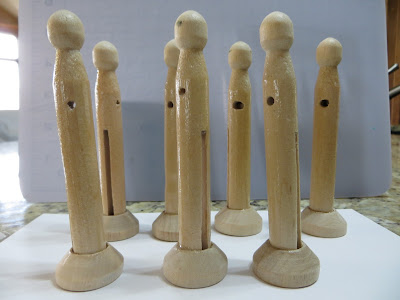This past weekend, I had clothespins left over from my Doll Dialogue, so I decided to make more clothespin dolls as little gifts for friends. It definitely is easier the 2nd time around. So here's my tutorial on clothespin dolls, with a little more details and pointers.
1- All supplies bought at Hobby Lobby. You need clothespins HL#740019. These have tapered ends, so will need a stand HL#174078. You can also get clothespins with flat end, and they can stand on their own but they are shorter than ones pictured above.
2- With a Dremel type tool, drill a 1/8" hole below the "head" and "neck". I bought the drill below from Michaels on clearance for $15, works great, lightweight, easy to use. It comes with 3 drill bits : 1/32", 5/64" and 1/8". There's a collet for each of the drill bits, which you have to change out depending on the drill bit you use, but otherwise very easy to handle.
3- Glue the clothespin into the stand. Lightly sand away the rough spots on the clothespin & stand. Then apply a coat of varnish or Deco Art's Triple Thick to the clothespin. The Triple Thick is almost like a paste and gives a shine similar to clear nail polish, but thicker. It's sticky, so watch for misplaced fingerprints.
4- For the head, you need DOWEL CAPS 1 1/4" with 5/8" hole HL#211177. With a pencil, draw the doll's hairline and outline of the face. Add where you would put the eyes.
5- Paint your doll's hair. You can have a doll with blond, brown, auburn, grey or black hair. I've seen clothespin dolls with pink, blue & green hair, so it's entirely up to you. Take special care to stay within the outlines of the drawn hairline. The birch wood absorbs the paint extremely well, and "erasing" mistakes is not easy, especially when using black paint.
I used Apple Barrel's Country Grey, Ceramcoat's Brown Bambi, Ceramcooat's "Hope" (pale yellow), and Anita's Glossy Black.
The EYES are easy to paint---you take the blunt end of a paintbrush, dip into paint color of choice (black, brown, blue) and place a dot where you want the eyes. This gives a nice round dot without much effort. Usually one dot is all that's needed, but use the blunt end of the brush and not the brush.
This is the clothespin glued into the base, holes drilled for the chenille stem arms. Now you can add flesh colored DMC embroidery floss to the chenille stem "arms". I used DMC 948, which has a peachy color. Reesa's blog recommends DMC 739, which is an ivory to cream color. Your choice.
For the ARMS, apply some clear drying glue to the chenille stem and wrap DMC floss (all 6 strands) from left to right so that no fuzzy hair sticks out between the floss. I used the tan chenille stem, but the white chenille stem "hair" may be less noticeable if you are not able to get the floss right up against each other.
You can leave some of the middle portion of the stem without floss, since you will not see them.
Being right hand person, I found it easiest to wind the floss from left to right.
After the varnish has dried, you can work on the BODICE of the dress. You can paint the bodice, but I used a 1" wide ribbon that I glued to the top portion of the clothespin.
To locate the drilled holes for the arm, use a quilting pin.
Take an Xacto knife and puncture the ribbon where the pin/hole is located.
The SKIRT is a circle, about 3.5" diameter. Take a 4" square of fabric, fold in half. Take your circle template, fold in half and pin to the folded fabric square. Cut the circle like you would for a valentine heart (the folded edge of fabric and circle template is the center).
You can add some lace to the skirt
If you use lace, you will need 12 inches of lace. Snip the INSIDE of the lace edge every quarter inch and glue to the underside of the skirt. The snips allow the lace to overlap and form a circle.
Here is the skirt right side up with lace edges on bottomside of skirt.
Fold the skirt in quarters to find the center of the skirt.
Take an Xacto knife and make a 0.75 inch wide slit in the center.
Now you can slip the skirt over the doll's HEAD.
Glue the skirt to the bodice.
You can add a quarter inch wide ribbon for the WAIST (plus it will hide the skirt's raw edges)
Insert the arms through the drilled holes.
Add glue to the clothespin HEAD and the doll's head. You need to let the glue set for 24 hours, or try Reesa's suggestion of using a hot glue gun.
The doll's head is larger than the clothespin head, so it will have a lot of wiggle room. In this picture, I had added some air drying clay to the doll's head to make for a tight fit. This will work, except, you need to add just A LITTLE BIT of clay---too much and the clay will extrude out when you put the head onto the clothespin. Make sure you have glue on the surface before you add the clay if you use this option, otherwise the clay will pop out when it is dry and hardened.















No comments:
Post a Comment